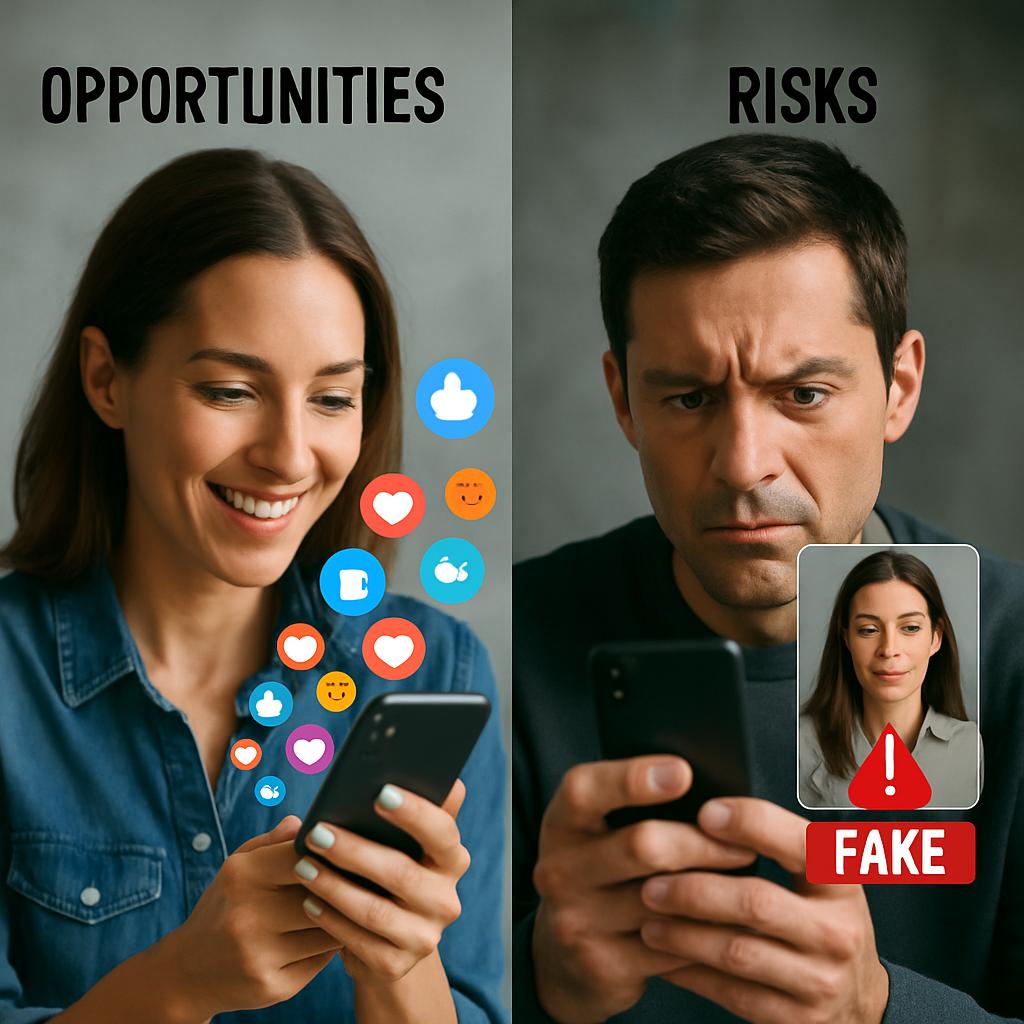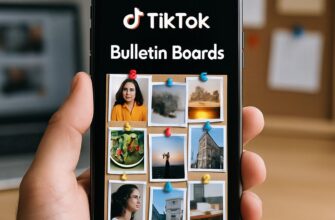The arrival of generative AI on social platforms feels like a new tool chest dropped into every marketer’s lap—powerful, messy, and tempting. From instant caption generation to whole short-video concepts, these systems can crank out ideas and assets faster than a small creative team. The rise of generative AI content in social media marketing: opportunities & risks is both an invitation and a warning; understanding the trade-offs matters more than ever.
- How generative AI fits into the social media toolkit
- Opportunities: what brands stand to gain
- Creative experimentation and diversity of ideas
- Cost efficiency and resource reallocation
- Rapid localization and accessibility
- Risks: what can go wrong and why it matters
- Misinformation and factual errors
- Brand safety and tone drift
- Intellectual property and copyright concerns
- Deepfakes, manipulation, and ethical boundaries
- Practical guardrails and governance
- Operational checklist for teams
- Practical implementation: workflows that work
- A real-world example from my work
- Measuring success and fine-tuning over time
- Cost-benefit considerations
- Preparing for the next wave
How generative AI fits into the social media toolkit

Generative AI models produce text, images, video, and audio from prompts, and social marketers are using them at every stage of the content lifecycle. They help brainstorm hooks, create variations for A/B tests, and even generate on-brand imagery that would otherwise require a photoshoot. Adoption is not about replacing creatives overnight but about folding AI into existing workflows to accelerate ideation and iteration.
The technology can also act as a magnifying glass for data. By feeding performance signals back into prompt engineering, teams can generate content that aligns with proven audience tastes. That loop—data informing creative prompts, and new creative producing fresh data—is where the biggest efficiency gains appear.
Opportunities: what brands stand to gain
Speed and scale are the most obvious benefits. Instead of a week-long content calendar planning session, a marketer can generate dozens of caption and image variants in an hour. That speed lets brands push more experiments, learn faster, and move on winners sooner.
Personalization becomes more accessible. With the right prompts and guardrails, brands can create tailored messages for different segments without writing each variant by hand. Small teams can suddenly operate like larger ones because AI reduces the creative labor required to serve many micro-audiences.
Creative experimentation and diversity of ideas
Generative models are excellent idea factories. They can respond to obscure prompt inputs and combine cultural references in ways human creators might not immediately think of. That capacity broadens the palette of concepts available to social teams and reduces creative block.
At the same time, models can produce multiple stylistic takes on a single brief—playful, authoritative, nostalgic—so teams can spot unexpected angles. These fresh directions can reveal messaging gaps or new brand personalities worth testing.
Cost efficiency and resource reallocation
Producing high-volume content without AI typically requires larger teams or agencies, which means higher budgets. Generative tools lower the marginal cost of an extra caption, thumbnail, or short clip. For many mid-size brands, that cost reduction translates to more frequent posting and a fuller, more consistent feed.
What often follows is resource reallocation: fewer hours spent on repetitive drafting and more time on strategy, community management, and high-touch creative projects. That shift can improve overall marketing quality if leaders invest the saved time wisely.
Rapid localization and accessibility
AI can quickly translate and localize content to reach diverse markets. For brands operating in multiple regions, this makes culturally adapted messaging feasible without hiring native writers for every locale. When combined with local performance data, localization can be both fast and targeted.
Additionally, AI tools can generate alternative text for images and produce captions for videos, improving accessibility. When implemented thoughtfully, these features expand reach while meeting compliance and inclusivity goals.
Risks: what can go wrong and why it matters

Generative AI carries serious risks alongside its benefits. Mistakes that feel small—an off-key joke, an inaccurate fact, or a creative that leans on stereotypes—can quickly amplify on social platforms. For brands, reputation damage and regulatory exposure are real hazards.
Because outputs are probabilistic rather than deterministic, even careful prompts can produce problematic content. That unpredictability means human review and clear approval processes are essential, not optional.
Misinformation and factual errors
Language models can confidently state incorrect facts, invent citations, or misreport data trends. For social posts that reach thousands or millions, a single error can erode trust. Brands that rely on auto-generated claims without verification risk public correction, loss of credibility, and potential legal problems if claims touch regulated areas.
Mitigation is straightforward in principle: verify any factual assertion, link to primary sources, and keep AI-generated claims in advisory drafts rather than final copy without human checks. In practice, teams need discipline and clear workflows to make verification routine.
Brand safety and tone drift
Models trained on wide swaths of internet text can echo language patterns that don’t fit a brand’s voice or values. A humorous tone for one brand can become flippant for another, and AI doesn’t automatically respect subtle brand rules. This drift can confuse audiences and damage long-term positioning.
To control tone, organizations should develop explicit style guides and build them into prompt templates. Consistent human editing remains the best defense against tone inconsistency and off-brand messaging.
Intellectual property and copyright concerns
Output from generative models sometimes closely mirrors training data, raising questions about originality and copyright. Visual content that resembles existing works or text that paraphrases proprietary materials can expose brands to legal risk. The regulatory environment is still evolving, and different jurisdictions treat these risks differently.
Practical measures include using licensed datasets, maintaining prompt records, and working with legal counsel when producing campaign assets that could be sensitive. When in doubt, opt for human-crafted assets or ensure clearance for AI-generated content.
Deepfakes, manipulation, and ethical boundaries
Generative models can create convincing synthetic media, which has legitimate uses but also enables deception. A manipulated video or voice clip shared on social media can spread quickly and cause real harm. Brands must be vigilant about how they use synthetic media and ensure transparency with audiences.
Ethical frameworks and platform policies should guide decisions around using deepfakes or synthetic endorsements. When a piece of content could be perceived as misleading, disclose its synthetic nature and prioritize authenticity.
Practical guardrails and governance
Effective deployment of generative AI requires policy as much as technology. A governance framework should define who can use AI tools, what datasets and prompt templates are permitted, and what approval steps are mandatory before publishing. Those rules protect both the brand and the legal interests of the organization.
Mandates should include human review checkpoints, obligatory fact-checking for claims, and documented prompt logs to understand how content was produced. These artifacts help with accountability and can be crucial if a post sparks controversy.
Operational checklist for teams
Below is a concise checklist marketers can adopt immediately to reduce risk while capturing AI’s benefits.
- Require a named reviewer for every AI-generated post before publishing.
- Maintain a living style guide and integrate it into prompt templates.
- Verify any factual statements with primary sources or remove them.
- Log prompts and outputs for campaigns that could present legal exposure.
- Disclose synthetic media where appropriate to preserve transparency.
Practical implementation: workflows that work
Successful teams treat AI as a creative assistant, not an autopilot. Start with low-risk tasks like caption drafts, hashtag brainstorming, and A/B copy variants. Use human editors to refine tone and ensure accuracy before scaling up to higher-risk content types.
Set up a cross-functional process that includes marketing, legal, and brand design. When a campaign escalates—for example, a product claim or influencer collaboration—escalate reviews accordingly and consider additional legal sign-offs.
A real-world example from my work
I once worked with a boutique apparel brand that used AI to generate Instagram captions and image variations for seasonal collections. We treated the tool as a first draft generator: the AI would produce 10–15 caption ideas and five thumbnail concepts, and a copy editor would refine the best two. The result was a faster content calendar and a measurable uplift in engagement from more frequent, fresher posts.
The turning point came when we added a weekly review meeting to catch tone drift and ensure the brand’s sustainability commitments were highlighted correctly. That small human-in-the-loop practice prevented a potentially awkward misstep and kept the team confident about scaling AI use.
Measuring success and fine-tuning over time
Metrics tell whether AI is helping or hurting. Key performance indicators should include engagement rates, error incidents (body counts of factual corrections or takedowns), brand sentiment, and time-to-publish. Track these metrics before and after AI adoption to understand real impact.
Continuous learning is essential: feed performance data back into prompt design and model selection. Often the best improvements come from small, iterative changes in prompts and review steps rather than wholesale swaps of tools.
Cost-benefit considerations
Not every content piece needs AI. Reserve generative tools for high-volume, low-risk tasks where speed and variety matter. For high-stakes messaging—corporate announcements, regulated claims, or sensitive topics—prioritize human-crafted content and rigorous approvals.
Think of AI as a lever that scales certain activities; it’s not a universal cost-saver. The organization still needs quality control, legal review, and brand strategy to make those scaled activities worthwhile.
Preparing for the next wave
Generative AI will continue to evolve, and social platforms will refine policies in response. Marketers should invest in skills that remain valuable: critical thinking, ethical judgment, and the ability to translate brand strategy into clear briefs. Those human strengths will determine whether AI amplifies a brand or amplifies its mistakes.
Adopt a test-and-learn posture but pair it with governance and cultural norms that prize transparency and accountability. That combination lets teams move fast without losing the guardrails that protect reputation and trust.
Generative AI offers a rare mix of creative capacity and operational efficiency, but it raises questions new to many marketing teams. Use it smartly: prioritize verification, maintain human oversight, and treat the technology as a collaborator rather than a substitute. If you want more practical guides, case studies, and templates to help implement these ideas in your organization, visit https://news-ads.com/ and read other materials from our website.







